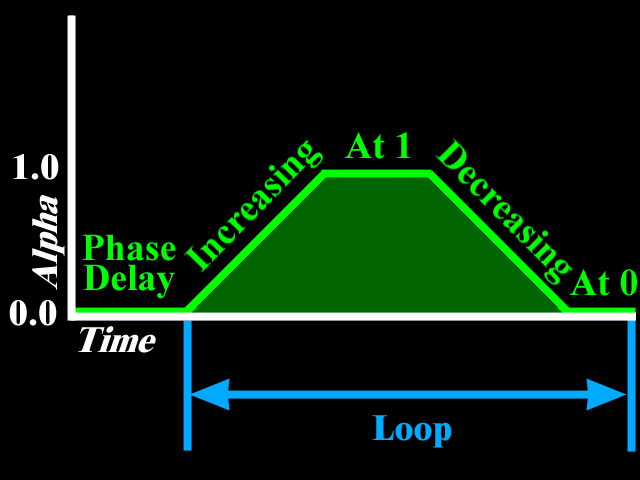Mapping time to alpha
-
An Alpha generator computes alpha using:
-
Trigger time
-
Phase Delay before initial alpha change
-
Increasing time for increasing alpha
-
At-One time for constant high alpha
-
Decreasing time for decreasing alpha
-
At-Zero time for constant low alpha
-
-
Increasing and decreasing phases may be individually enabled or disabled and their acceleration controlled
-
Increasing ramp controls increasing acceleration
-
Decreasing ramp controls decreasing acceleration
-

An alpha object produces a value, called the alpha value, between 0.0 and 1.0, inclusive. The alpha value changes over time as specified by the parameters of the alpha object. For specific parameter values at any particular time, there is only one alpha value the alpha object will produce. Plotting the alpha value over time shows the waveform that the alpha object produces.
The alpha object waveform has four phases: increasing alpha, alpha at one, decreasing alpha, and alpha at zero. The collection of all four phases is one cycle of the alpha waveform. These four phases correspond with four parameters of the Alpha object. The duration of the four phases is specified by an integer value expressing the duration in milliseconds of time. All alpha timings are relative to the start time for the Alpha object. The start time for all Alpha object is taken from the system start time. Consequently, Alpha objects created at different times will have the same start time. As a result, all interpolator objects, even those based on different Alpha objects, are synchronized.
Alpha objects can have their waveforms begin at different times. The beginning of an alpha object's first waveform cycle may be delayed by either or both of two other parameters: TriggerTime and PhaseDelayDuration. The TriggerTime parameter specifies a time after the StartTime to begin operation of the Alpha object. For a time specified by the PhaseDelayDuration parameter after the TriggerTime, the first cycle of the waveform begins.
An alpha waveform may cycle once, repeat a specific number of times, or cycle continuously. The number of cycles is specified by the loopCount parameter. When the loopCount is positive, it specifies the number of cycles. A loopCount of 1 specifies continuous looping. When the alpha waveform cycles more than once, only the four cycles repeat. The phase delay is not repeated.